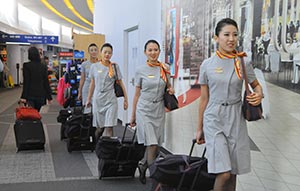

Guangdong, one of China's economic powerhouses, is conducting a feasibility study of a free trade zone in cooperation with the neighboring Hong Kong and Macao special administrative regions, insiders said.
They said that officials in the southern province have been urged to apply "immediately" for central government approval to begin construction of the FTZ.
The zone would encompass the Nansha district in Guangzhou, capital of Guangdong, as well as Hengqin island in the Zhuhai special economic zone, the Qianhai area in the Shenzhen SEZ and Guangzhou airport's comprehensive development zone, they added.
Guangdong media reports said the central government may approve the FTZ in early 2014.
In August, the State Council, China's cabinet, gave Shanghai permission to set up the mainland's first FTZ, moving it closer to becoming a global financial, trade and shipping hub to rival other Asian cities such as Hong Kong.
The Shanghai FTZ, covering 28.78 square kilometers, will take more than 10 years to complete. It will be built on the base of Shanghai's existing bonded zones: the Waigaoqiao Free Trade Zone, the Waigaoqiao Free Trade Logistics Park, the Yangshan Free Trade Port Area and the Pudong Airport Comprehensive Free Trade Zone.
In 2010, the State Council designated the Nansha district, Hengqin island and the Qianhai area as three pilot sites for policies to boost regional economic integration in Guangdong.
"Including Guangzhou airport's development zone into an FTZ will be a big plus for Guangdong's application, since Guangzhou Baiyun International Airport has become a global aviation hub," said Lin Jiang, a professor at Guangzhou-based Sun Yatsen University.
Airlines using Guangzhou Baiyun, one of the three busiest airports in the mainland, serve 122 international routes, according to the airport authority.
Lin said Guangdong's FTZ will emphasize the development of the finance, services and free trade sectors. The zone will further upgrade Guangdong's processing industries, which play a big part in the province's economic growth.
 Models at Ford pavilion at Chengdu Motor Show
Models at Ford pavilion at Chengdu Motor Show
 Brilliant future expected for Chinese cinema: interview
Brilliant future expected for Chinese cinema: interview
 Chang'an launches Eado XT at Chengdu Motor Show
Chang'an launches Eado XT at Chengdu Motor Show
 Hainan Airlines makes maiden flight to Chicago
Hainan Airlines makes maiden flight to Chicago
 Highlights of 2013 Chengdu Motor Show
Highlights of 2013 Chengdu Motor Show
 New Mercedes E-Class China debut at Chengdu Motor Show
New Mercedes E-Class China debut at Chengdu Motor Show
 'Jurassic Park 3D' remains atop Chinese box office
'Jurassic Park 3D' remains atop Chinese box office
 Beauty reveals secrets of fashion consultant
Beauty reveals secrets of fashion consultant